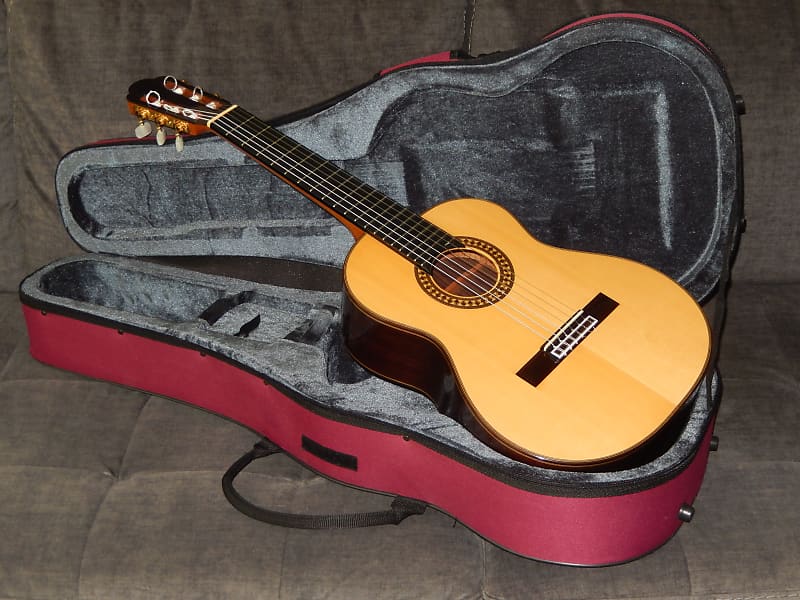

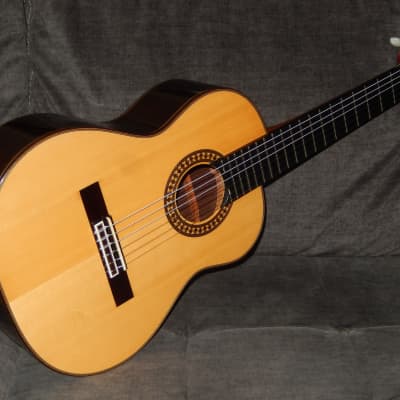
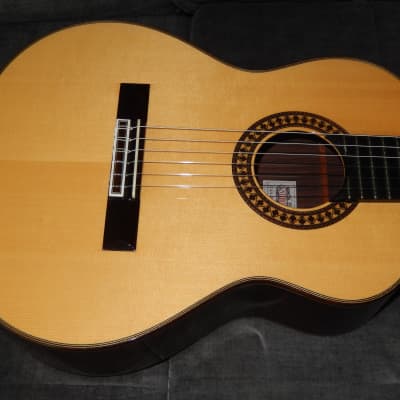
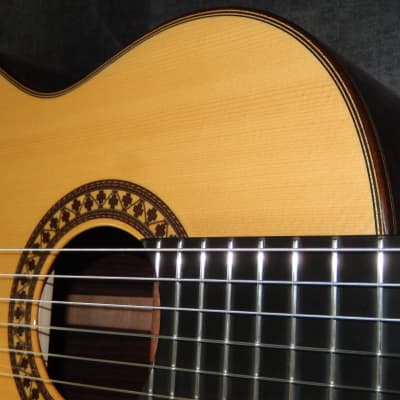
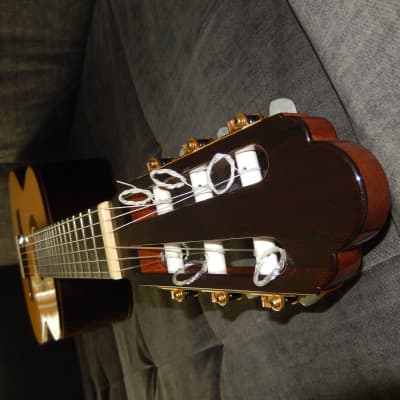
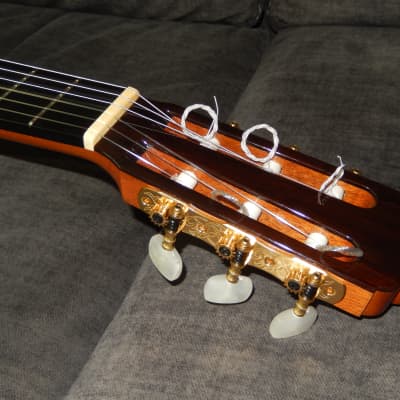
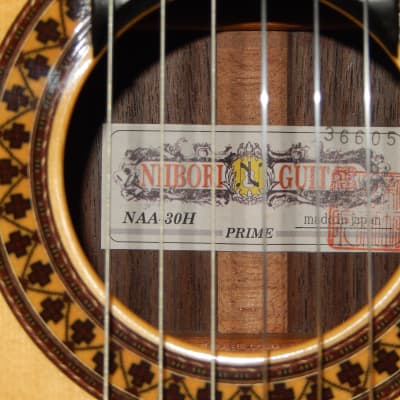
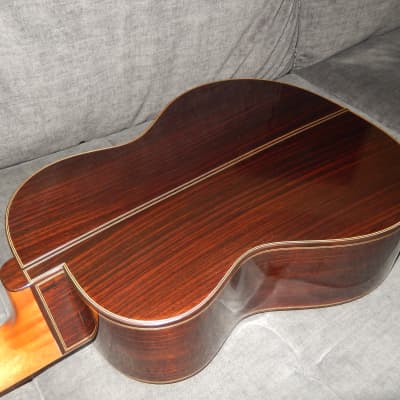
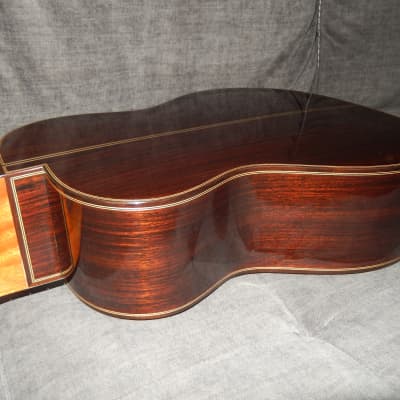
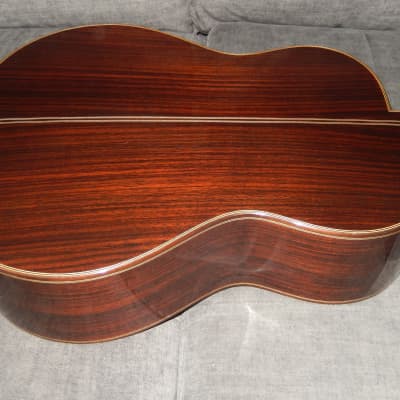
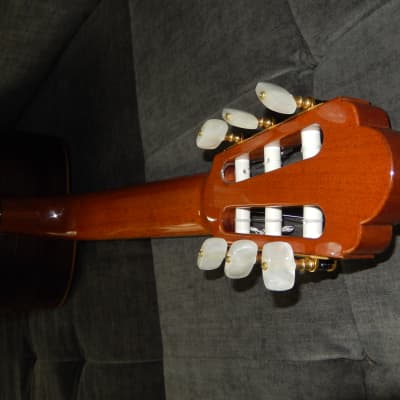
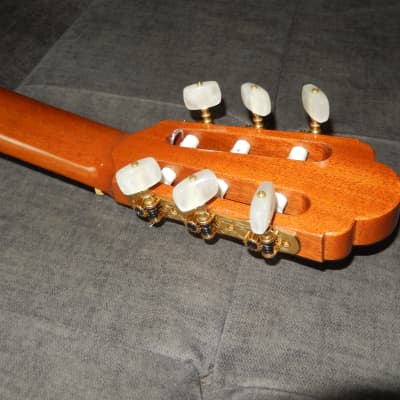
Several hundred guitars I have sold in the past are presented at Facebook.com/Victors.Guitar.Library.
Nibori Alto Guitar NAA-30H 530mm scale
This guitar was ordered by Nibori Music Academy and made in mid/late 1990s by legendary Japanese luthier Saburo Nogami. Most likely it was made at his workshop later known as Oshima Village workshop. Red stamp on the label bears Saburo Nogami's name.
Saburo Nogami's long time cooperation with Nibori School of Guitar Ensamble (later renamed to Nibori Music Academy) started in mid1970s.
Saburo Nogami was the first ever apprentice at Masaru Kohno workshop. He joined Kohno in 1959 and left his workshop in early 1970s. Saburo Nogami's level of craftsmanship was at least equal to Kohno's and he became a luthier legend on his own. During his long career besides making regular classical guitars he was also making alto, bass & contrabass guitars, lutes, vihuelas, and many traditional Japanese string instruments. Many of these "exotic" instruments were greatly decorated with carvings and paintings and made as "only one of the kind". Saburo Nogami's guitars and other instruments were and still are highly priced not only in Japan.
Saburo Nogami however was deeply engaged in making guitars for average "boy and girl". In mid 1970s Saburo supervised production of several guitar models made for Zen-On Music Co, Niibori School of Guitar Ensemble and Nishin Kogyo Co. Great majority of these guitars were made with "laminated" b/s. Laminated is quite "unfortunate" term regarding Japanese made guitars. These "laminates" were made from 2 layers of solid wood glued together with natural resins. They were made so well that they performed as good as solid woods while being far less expensive in guitar production. Since late 1970s through late 1990s Saburo Nogami was also closely cooperating with Kazuo Yairi, supervising production of many Kazuo Yairi's models at Yairi's Gifu factory. Yet again most of these absolutely wonderful instruments were made with "laminated" b/s.
This guitar remains in "practically mint" cosmetic and structural condition.
This guitar produces truly wonderful notes, very clear, glassy, yet very colorful trebles, somewhat metallic basses, all very well separated, and all with very impressive sustain. Despite its smaller (alto) body guitar, its volume is quite impressive too.
Being priced 300 000 yen in 1990s it was quite expensive instrument. The same grade brand new alto guitars made by Japanese elite luthiers are priced at least $5000. Solid top Alto model made by Asturias if available on US market, would be priced at least $3000.
Regarding the sound alone, this guitar is very competitive to $8000+ altos currently made by leading European or American guitar makers.
When contemporary Japanese luthiers are using 40+ years old soundboards to make “all solid woods” guitar it is priced at least $5000USD. Guitars with artificially aged (“baked”) soundboards are priced at least $4500USD. Solid top models with 40+ years old soundboards are priced at least $3500USD. American, Australian and European luthiers usually charge 50% more.
It is a matter of basic education (not beliefs) to realize that 40+ years old soundboard of this guitar alone is worth $2500USD.
Specifications:
Total length: 860mm
Body length: 415 mm
Body depth: 98-102 mm
Upper bout width: 245 mm
Lower bout width: 325 mm
Waist width: 210 mm
Top: AAA Grade Solid Spruce/lacquer
Back & Sides: Solid Indian Rosewood/lacquer
Neck: Spanish Cedar
Fingerboard: Ebony
Scale: 530 mm
Nut width: 50 mm
String spacing at the nut: 41 mm
String spacing at the bridge: 56 mm
Its current action is set to 3.50 mm under E6 and 3.00 mm under E1, with plenty of extra room on the saddle.
This guitar will be shipped in used original hard polyfoam case in still excellent condition.
Guitar is currently strung with D'Addario EJ52 ProArte Alto Strings designed for alto (B-B) tuning. If you'd like to play it with regular (E-E) tuning, you need regular classical guitar strings. Alto strings are of much lower gauge than regular strings, hence would feel too soft in regular (E-E) tuning. You must not try alto tuning with regular strings because that could lead to ripping off the bridge of the guitar.
Guitar ensemble and guitar orchestra music has been developed and promoted by Hiroki Nibori since 1957 and is gaining popularity among guitar players throughout the world. Playing in a group is great fun. It is an excellent opportunity to make new friends and learn from the more advanced players. One of the most valuable aspects of playing in a guitar ensemble is that it gives students the exposure of playing on a stage in front of an audience. When you combine the sounds of alto, bass, and contra bass guitars with standard (prime) guitars, a whole new world of sound comes alive. Even the beginner will find it easy to pick up any of these guitars and enjoy a variety of new and exciting musical styles.
An ALTO GUITAR is usually tuned a 5th higher than a standard (prime) guitar. Its open tuning notes sound the same as a standard guitar played on the 7th fret position: B,E,A,D,F#,B.
BASS GUITAR is tuned 4th lower than standard guitar, one octave lower than Alto guitar: B,E,A,D,F#,B
CONTRA BASS GUITAR is tuned one octave lower than standard guitar: E,A,D,G,B,E
Reverb Buyer Protection
Reverb has your back if your item is lost, damaged, or doesn't match its description. Simply report any issues within 7 days and we'll help you get a full refund.Learn more about Reverb Buyer Protection.
| Listed | 5 years ago |
| Condition | Mint (Used) Mint items are in essentially new original condition but have been opened or played.Learn more |
| Brand | |
| Model |
|
| Finish |
|
| Categories | |
| Year |
|
| Made In |
|
| Body Shape |
|
